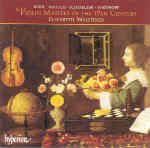Violinist Elizabeth Wallfisch’s disc of solo violin repertoire from the 17th century is an unusual and mostly interesting mix that includes Biber’s G minor Passacaglia, Schmelzer’s Sonata Quatra in D major, six suites by Johann Paul von Westhoff, and five short works by the Italian Nicola Matteis (his B-flat major Fantasia, Musica grave, Andamento malinconico, Alemanda facile, and Scaramuccia–the last four of which are solo violin arrangements by Wallfisch herself, adapted from various chamber works). Taken together, they provide an interesting insight into the foundations of composing for solo violin, an instrument that only recently had been making the transition from being an ensemble instrument used generally for dance music to one worthy of solo repertoire. The frequent double- and triple-stops and scordatura (in which the instrument is retuned to fit the key of a particular piece) make their connection to Bach’s later contrapuntal writing quite obvious.
Wallfisch has brought to disc some rarely heard works, and she should be given some measure of praise for that. However, regarding the performances themselves, this recording is recommended only for those seriously interested in the repertoire. No doubt the pieces are technically demanding, but Wallfisch’s bowing often is distressingly rough, and the buzzy wolfing is annoying. (This problem is all over the disc, but it’s excruciating by the second track, the Schmelzer.) Granted, some edginess of tone and timbre is to be expected with this repertoire and period instruments, but Wallfisch is so exposed (particularly in Hyperion’s super-bright recording) that there’s nowhere to hide, and nowhere else to turn your attention. Proceed with caution.
































